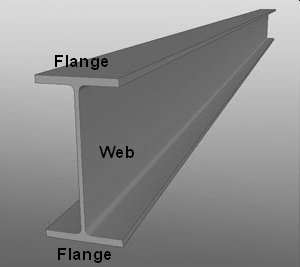Flanges in construction

|

|
[edit] Introduction
A flange is a projecting ridge, rim, collar or ring on an object such as a column, beam, pipe and so on that provides additional strength or stiffness or additional surface area for the attachment of, or to, another object. For example, flanges may be used to strengthen beams, or to connect or terminate pipes.
Where another object is to be attached, a flange may include bolt holes.
[edit] Pipework flange
Flanges are used in pipework systems for connecting and attaching pipes, valves, pumps, and so on. As an external or internal ridge, or rim, flanges are usually designed to interface sections of pipe and enable easy assembly and disassembly.
Typically, a flange is a forged or thrown ring of stainless steel that is welded or screwed to another component in the system. To create a flanged joint in a pipe system, two connecting pieces with flanges at the end are bolted together, with a seal provided by a gasket between them.
The dimensions of flanges are determined by the size of the pipe as well as the pressure class required for the application. The pressure class ratings that flanges are designed to are typically: 150 lb, 300 lb, 400 lb, 600 lb, 900 lb, 1,500 lb, and 2,500 lb. There are many different flange standards worldwide, with organisations such as ASME, MSS, and API publishing standards.
There are numerous types of flanges, including:
- Blind: This is a plate for covering or closing the end of a pipe, mainly used as part of high pressure weight applications.
- Expander: The non-flanged end is larger than the flanged end. This is used to change the size of a pipe run.
- Groove/tongue: This combination of a raised ring (tongue) and depression (groove) align together precisely.
- High hub blind: This is a simple round plate without a centre hold.
- Lapped joint: Used on applications with lap joint stub ends or lapped pipes, typically where cleaning or inspection is regularly required.
- Orifice: Typically used with orifice metering systems for gauging liquid and gas flow rates.
- Plate: Similar to a gasket, typically used in applications made from casting.
- Reducing: Used in applications with different pipe diameters.
- Ring type joint: A metal ring with a hexagonal groove compressed to a flange to form a seal.
- Slip-on: This flange slips over the pipe and is welded at the top and base side.
- Socket weld: Pipes are inserted into the sockets of flanges and welded for smooth flow. This tends to be used for smaller pipes.
- Spectacle: Comprises two discs attached with the help of a small metal (usually stainless steel, alloy steel, etc.) section.
- Square: A square-shaped flange.
- Threaded: This flange is fixed to a pipe using threads rather than welding, and so are more commonly used for low pressure applications.
- Weld neck: This helps transfer stress from flange to pipe, and is suitable for high pressure applications.
- Weldo/Nipo: A combination of weld neck flange and a nipolet (a one-piece fitting for valve take-offs, drains and vents).
[edit] Related articles on Designing Buildings
Featured articles and news
A change to adoptive architecture
Effects of global weather warming on architectural detailing, material choice and human interaction.
How big is the problem and what can we do to mitigate the effects?
Overheating guidance and tools for building designers
A number of cool guides to help with the heat.
The UK's Modern Industrial Strategy: A 10 year plan
Previous consultation criticism, current key elements and general support with some persisting reservations.
Building Safety Regulator reforms
New roles, new staff and a new fast track service pave the way for a single construction regulator.
Architectural Technologist CPDs and Communications
CIAT CPD… and how you can do it!
Cooling centres and cool spaces
Managing extreme heat in cities by directing the public to places for heat stress relief and water sources.
Winter gardens: A brief history and warm variations
Extending the season with glass in different forms and terms.
Restoring Great Yarmouth's Winter Gardens
Transforming one of the least sustainable constructions imaginable.
Construction Skills Mission Board launch sector drive
Newly formed government and industry collaboration set strategy for recruiting an additional 100,000 construction workers a year.
New Architects Code comes into effect in September 2025
ARB Architects Code of Conduct and Practice available with ongoing consultation regarding guidance.
Welsh Skills Body (Medr) launches ambitious plan
The new skills body brings together funding and regulation of tertiary education and research for the devolved nation.
Paul Gandy FCIOB announced as next CIOB President
Former Tilbury Douglas CEO takes helm.
UK Infrastructure: A 10 Year Strategy. In brief with reactions
With the National Infrastructure and Service Transformation Authority (NISTA).
Ebenezer Howard: inventor of the garden city. Book review.
Airtightness Topic Guide BSRIA TG 27/2025
Explaining the basics of airtightness, what it is, why it's important, when it's required and how it's carried out.





















